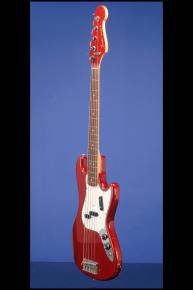A Custom-Color First Generation Fender Bass V
This very rare early custom-color Bass V weighs 9.40 lbs. and has a nut width of just under 1 3/4 inches and a full bass scale length of 34 inches. Solid alder body, contoured on back and lower bass bout, one-piece "birds-eye" maple neck with a medium profile, and veneer rosewood fretboard with 15 frets and pearloid dot position markers. Headstock with matching Candy Apple Red finish and decal with "Fender BASS V" logo in gold with black trim and five patent numbers in black below it. "Offset Contour Body" decal on the ball end of the headstock. Triple string tree. Individual Fender bass tuners with cloverleaf-shaped metal buttons. Four-bolt neck plate with large Fender backward "F" logo in the center and serial number ("600278") between the top two screws. One split black five-polepiece pickup (three plus two) with a great, fat output of 10.26k. Three-layer (white/black/white) plastic pickguard with fifteen screws. Thumbrest on the bass side of the pickguard. Two controls (one volume, one tone) and jack socket, all on metal plate adjoining pickguard. Black plastic ribbed-sided conical-shaped "Witch Hat" knobs with metal tops. The potentiometers are stamped "137 6605" (CTS February 1966). Combined individually adjustable five-saddle bridge/tailpiece with the original chrome cover. This guitar is in exceptionally fine (9.00) condition, with a minuscule amount of belt buckle marking on the back, a couple of minor dents on the top, and a few small chips on the edges. This is one of the earliest examples of the Fender Bass V (the first five-string bass with normal string spacing -- tuned E A D G C), with an unbound dot-marker fretboard, and one of a very few made in a custom color with matching headstock. This guitar has a really beautiful "birds-eye" maple neck and the Candy Apple Red is completely unfaded. It is certainly one of the prettiest Bass Vs that we have ever seen. Housed in the original Fender black hardshell case with orange plush lining (8.50).
"In 1965, just as the torch was being passed to CBS, the bass V made its appearance, even though it was a typical pre-CBS design. By its overall look it was actually a 5 string compromise between the Jazz Bass and the P. Bass. It had a split pickup in which the bass portion had two pole pieces while the treble portion had three, a Jazz Bass type control plate but with only one master volume and one master tone as there was only a single pickup. If you look closely at it, you will see that everything is in conformity: the style of the headstock (elongated for the placement of a fifth key), the pickguard, the covers (with a large 'F' on the bridge one) and the body (elongated as well). You could almost say that apart from the fifth additional string, a high C, it is very similar to the P. Bass with its 1 3/4" nut width. The other major difference was the fact that the neck was shortened although the scale of the bass remained at 34". In effect, thanks to this 5th string it was no longer necessary to have 20 frets and therefore you only find 15 on this model. The rosewood capped neck and round position dots later became white binding with large position markers in 1966, and then maple capped, black binding and large position markers in 1967 and finally in 1970 one piece maple or rosewood capped with white binding and large position markers. We should note that the strings were passed through the body as with the 1st P. Bass and its re-edition; the Telecaster Bass 1st version. The finishes are identical to the other three basses of the period: the P. Bass, Jazz Bass and Bass VI. The Bass V made its last catalogue appearance in 1969 and dispareared [sic] in 1971 without a trace" (Klaus Blasquiz, The Fender Bass, p. 26).
"After Leo Fender sold his company to CBS in January 1965, the new management introduced a number of unusual instruments, including [a] 5-string bass. It added a high C string to the usual EADG and had only 15 frets. James Jamerson owned a Bass V and may have experimented with it occasionally in the studio" (Jim Roberts, How the Fender Bass Changed the World, p. 69).
Translate:









